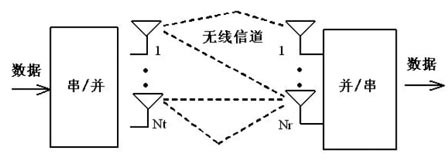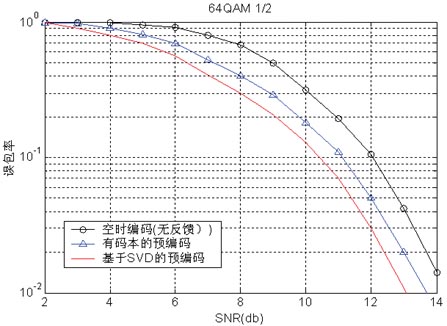Summary of Closed-loop MIMO Technology in Wireless Communication System
Summary
Multiple input multiple output (MIMO) technology is considered to be one of the key technologies of next-generation wireless communication. This article mainly discusses closed-loop MIMO technology that can further increase the capacity of multi-antenna systems, that is, MIMO system with feedback. The feedback channel information can not only improve the transmission performance of a single link, but also optimize the scheduling problem among multiple users. We present several closed-loop MIMO schemes that may be used in future wireless communication systems, including SVD decomposition and codebook-based precoding techniques, and analyze and compare their performance. Simulation results show that closed-loop MIMO technology will effectively improve the performance of the communication system.
1 Introduction
Multiple input and multiple output (MIMO) technology using multiple transmit and receive antennas is one of the key technologies for next-generation wireless communication. It can effectively utilize random fading and possible multipath propagation to increase the transmission rate. Both 3G-LTE and WiMAX systems have adopted MIMO technology to improve their performance. IEEE802.16e and WCDMA products have already realized the functions of MIMO system.
The transmission scheme of the MIMO system is mainly divided into two types: a spatial multiplexing scheme (SpaTIal MulTIplexing, SM) to maximize transmission rate and a space-time coding scheme (Space-TIme Coding, STC) to maximize diversity gain. Spatial multiplexing mainly realizes spatial multiplexing by transmitting independent signals on different antennas, such as the BLAST algorithm. Space-time coding, such as STBC and STTC space-time algorithms, can obtain diversity gain, but cannot increase the data rate.
The transmitters of the above two schemes do not need channel information (CSI), which is called open loop MIMO system. In situations where the channel changes slowly, such as indoor environments in large cities and nomadic access services, closed-loop MIMO systems can further improve system performance. In the closed-loop MIMO system, the receiving end feeds back channel information to the transmitting end, and then performs precoding, beamforming, or antenna selection on the transmission data. The feedback method of closed-loop MIMO can be divided into full feedback and partial feedback. Full feedback is to feed back all channel information to the transmitter. Since the feedback link takes up system overhead, in actual systems, partial feedback techniques are generally used. For example, the statistical characteristic value of the feedback channel, the SVD decomposition value, the codeword number based on the codebook, etc., to achieve a trade-off between performance and complexity.
In mobile communication systems, multipath and multipath delay spread are the main problems in mobile communication. Multipath propagation will cause severe signal fading, and delay spread will cause inter-symbol interference, which will seriously affect the quality of the communication link. In order to overcome the fading in the wireless channel, OFDM technology has also been introduced into the next-generation wireless communication system, combined with MIMO technology to form the physical layer core technology of the next-generation wireless communication technology.
This article mainly discusses closed-loop MIMO technology. We give typical precoding schemes based on SVD decomposition and codebooks, and then compare their complexity and performance. Finally, they give simulation results and discuss their applications in next-generation wireless communication networks.
2 System model
As shown in Figure 1, a MIMO system model with Nt transmit antennas and Nr receive antennas can be expressed as:
y = Hs + n (1)
Where y ∈ CNr × 1, s ∈ CNt × 1 and n ∈ CNr × 1 represent the received symbol, the transmitted symbol and the additive Gaussian noise sequence, respectively, H ∈ CNr × Nt is the channel matrix.

Figure 1 MIMO system structure diagram
If the transmitter knows the information of channel H, the channel can be pre-coded (beamforming) to obtain better transmission performance. The channel information can be obtained by feedback from the receiving end or sending the training sequence to the transmitting end. This is a closed-loop MIMO system, and its general structure is shown in Figure 2

Figure 2 Block diagram of a closed-loop MIMO system
The precoding process of the transmitting end of the closed-loop MIMO system is realized by multiplying the precoding matrix P and the transmitted data:
y = HPs + n (2)
= (HP) -1y
When the transmitter can obtain accurate channel information, the best transmission method can be obtained by singular value (SVD) decomposition of the channel matrix m (mr = UHy = UH (HVs + n) = UH (UDVH) Vs + UHn = Ds + UHn (3)
r = Ds + UHn
= D-1r

Figure 3 Closed-loop MIMO SVD structure diagram
Among them, U and V are the preprocessing matrix of the receiving end and the transmitting end, D is the singular value matrix of the channel H, U and V are unitary matrices, and D is the diagonal matrix.
3 Closed-loop MIMO technology analysis
3.1 Codebook-based precoding technology
In the actual communication system, the feedback channel information will occupy more resources, and in the fast fading channel, the efficiency and accuracy of the feedback information are relatively high. At this time, the partial feedback method is more appropriate. The most typical partial feedback schemes include: codebook-based precoding, statistics-based precoding, etc. After receiving the training sequence, the receiving end searches for the best precoding matrix from a series of codeword sets, and feeds back its serial number and channel signal-to-noise ratio information to the transmitting end.
The construction and selection of codebook is the primary issue of precoding technology. The codebook is a quantization of the optimal precoding matrix. The size of the codebook and the distance between each codeword affect the performance of precoding. Typical codebook construction includes Grassmannian method and orthogonal codeword construction method. The former is based on the decision of the Grassmannian manifold to maximize the Euclidean distance between any two codewords, the latter is constructed using orthogonal matrices, such as FFT, DCT and Harmard matrix. The former is an irregular codeword, and there is interference between the two codewords, while the latter is arbitrary between any two codewords.
3.2 Precoding technology based on SVD decomposition
SVD decomposition is equivalent to the precoding technology of virtual m (m3.3 multi-user system
As MIMO technology matures, multi-user MIMO technology will also be applied to actual wireless communication systems. Typical applications, such as multi-user diversity transmission and multi-user detection for mobile stations with multiple receiving antennas, maximize system throughput. The precoding (beamforming) method selects the user with the highest SNR and minimizes the interference between different users. Compared with a point-to-point system, the base station must not only process the channel information fed back by different mobile stations, but also perform matrix matching on the precoding between different users to obtain the best data transmission.
For the above precoding (beamforming) schemes based on channel information, the optimization criteria for the transmission and reception mechanisms include:
(1) Error of channel information (CSI);
(2) Design of feedback information (codebook);
(3) Optimization strategy of feedback information (selection of codebook).
4 Simulation to verify the effect of precoding. We use the ITU channel model (walking A, 3km / h), set the number of transmitting antennas to 2, the number of receiving antennas to 2, the modulation method to 64QAM, and use 1/2 convolutional coding. The correlation coefficients of the transmitting antenna and the receiving antenna are 0.2 and 0 respectively, and the channel is a flat-fading Rayleigh channel model. It is assumed that the channels between the antennas are independent of each other. The packet error rate curve based on STC space-time coding without feedback, SVD precoding feedback and ideal feedback is shown in Fig. 4. It can be seen from the figure that the closed-loop MIMO system is superior to the open-loop system, and the SVD-based AND coding system is superior to the precoding system with a codebook. 
Figure 4 Performance comparison of closed-loop and open-loop MIMO systems
5 Conclusion
From the above discussion and simulation results, it can be seen that closed-loop MIMO technology is a very promising technology in future mobile communications. As the application of MIMO technology in cellular networks becomes more and more mature, research on MIMO technology has also expanded from a single-user point-to-point environment to a multi-user MIMO system. The closed-loop solution of multi-user MIMO is also one of the research hotspots of 3G LTE and WiMAX systems. The most common solutions include: block diagonalization, successive optimization, beamforming, and combined space-time coding to eliminate interference between multiple users.
For a closed-loop MIMO-OFDM system, if channel information feedback is required for each subcarrier, the feedback link has a large overhead. How to design to reduce the amount of feedback data is also one of the research hotspots in MIMO-OFDM systems.
Portable Heater Fan is ideal for use in an office or a small room. This heater is an automatic thermostat control with four positions for fan only, warm, hot, as well as off. The Heater Fan has a safety switch to shut off when tip over. It also has a thermal cut-off safety, a thermal fuse and a indicator light to let you know when it is working or not. This Fan Heater has two heat settings: 1000 and 2000 watts. When you just want to circulate some air, you can set it to cool fan only. or Keep warm when winter.
Portable Heater Fan, normal specialize as below:
- 2 heat settings (1000 and 2000 watts)
- Automatic thermostat control
- 4-position function switch (off, fan, warm and hot)
- Cooling Fan forced only setting
- Thermal fuse
- Thermal cut-off link
- Tip-over safety switch
- Power indicator light
Fenry have special portable fan heaters with 3 settings: 800W/1200W/2000W or 1200W/2400W with model number 809 series.
If you need, please contact us
thanks
Mainstays 2 In 1 Heater With Fan,Warmwave Space Heater,Portable Heater Blower,Portable Electric Fan Heater
Fenry manufacturing Co., Ltd , https://www.cnfenry.com
